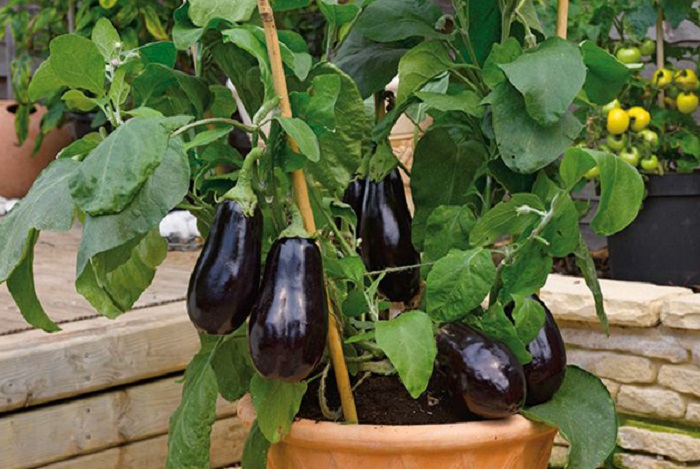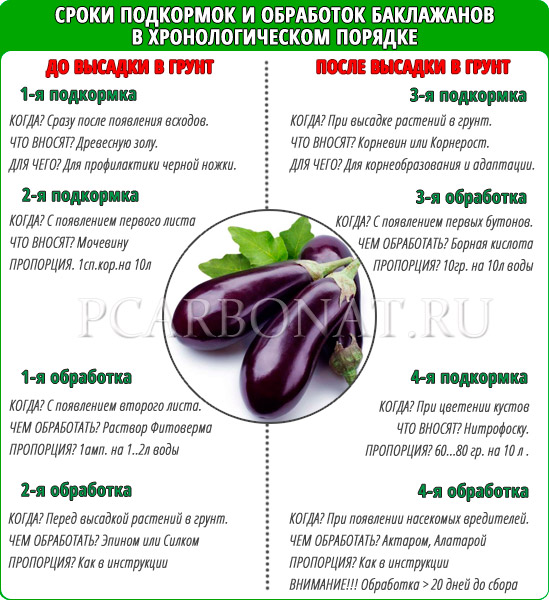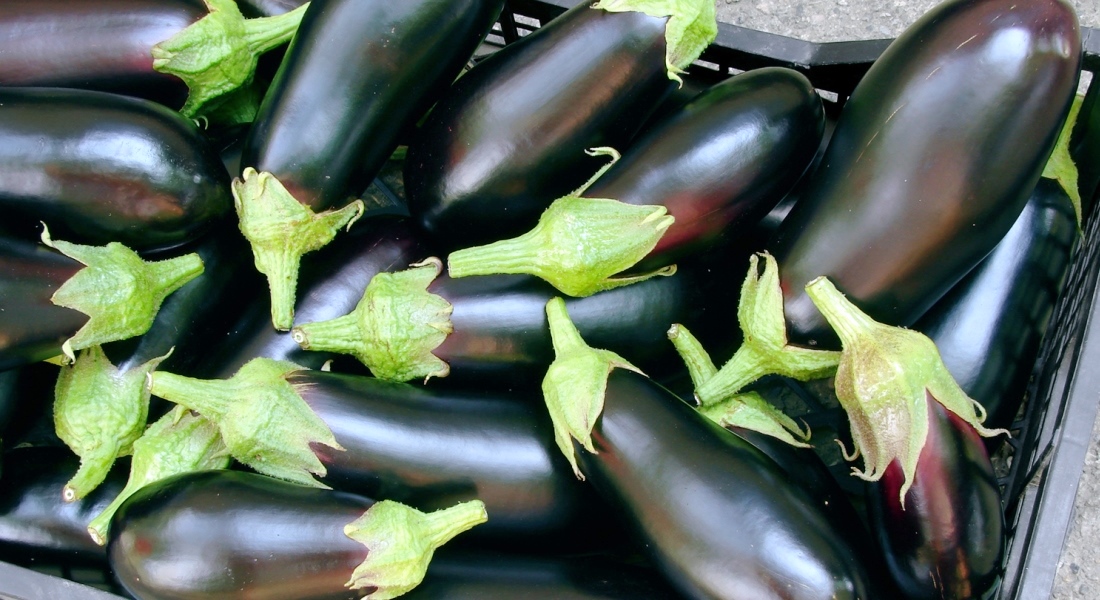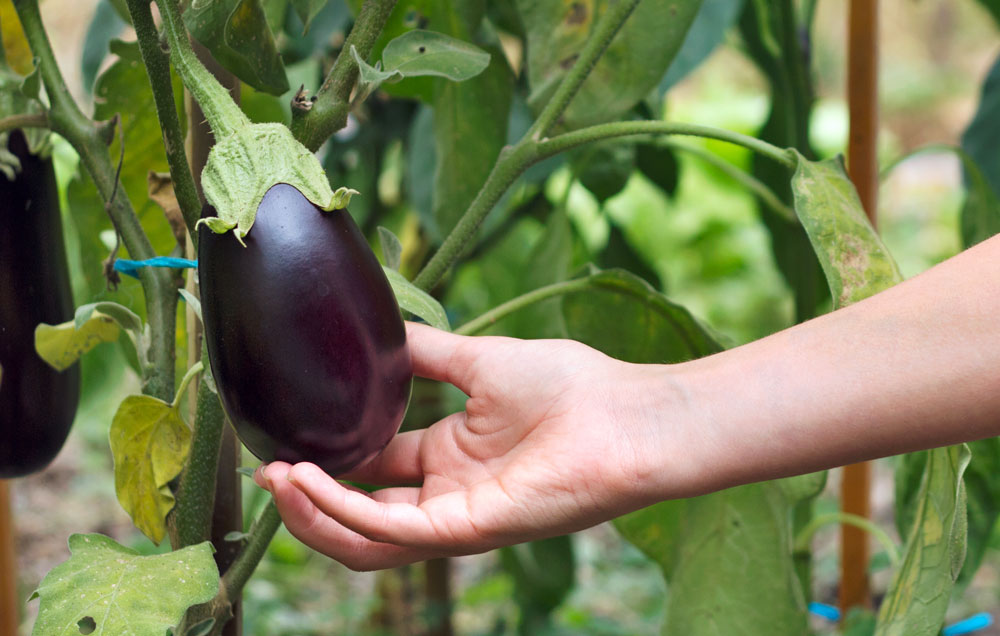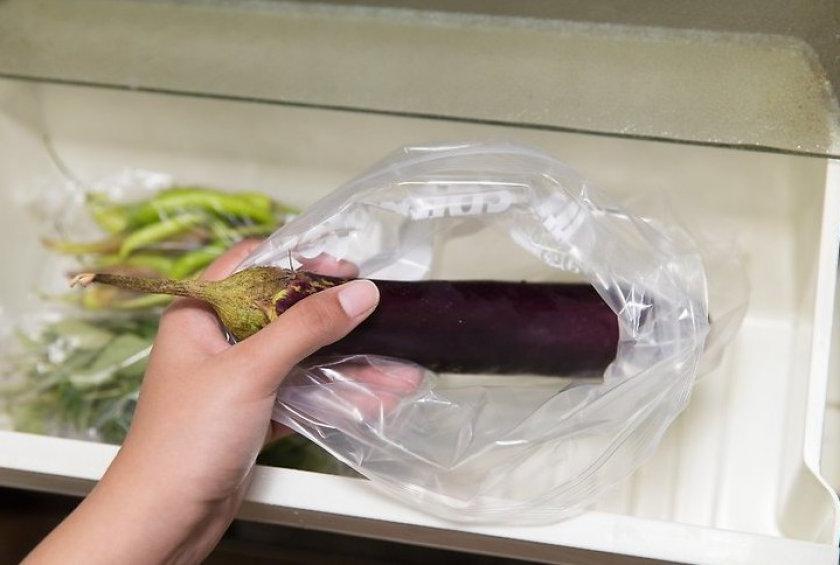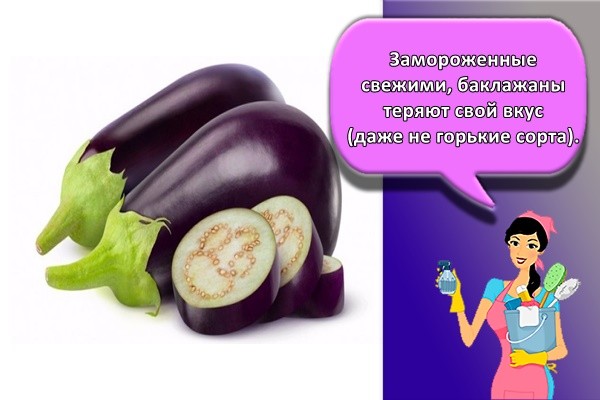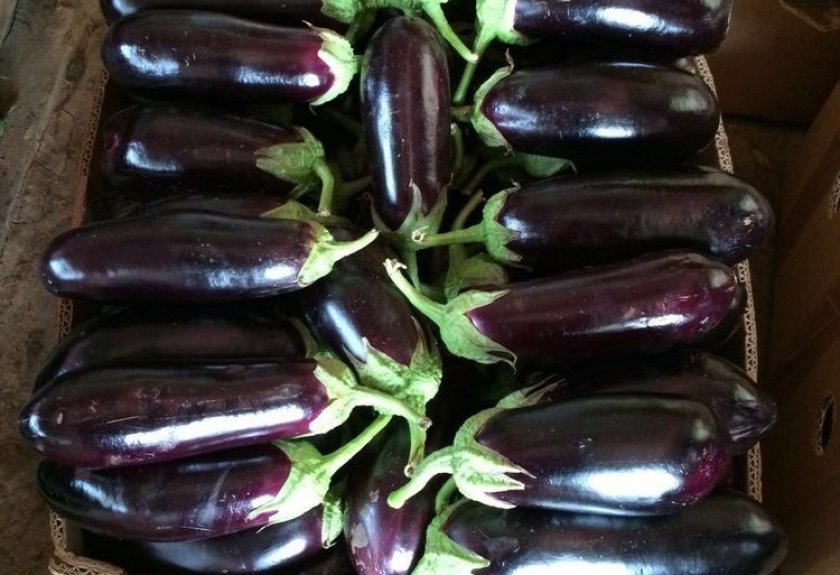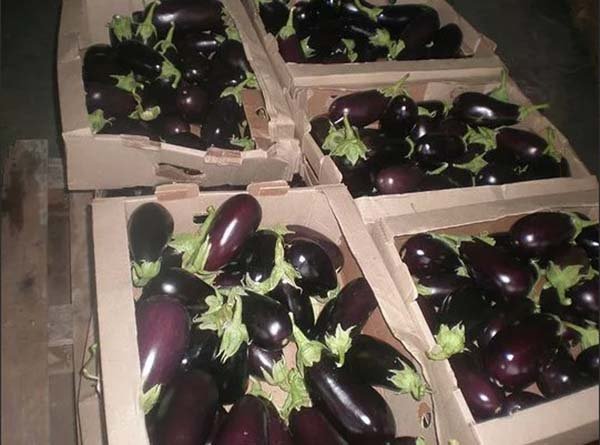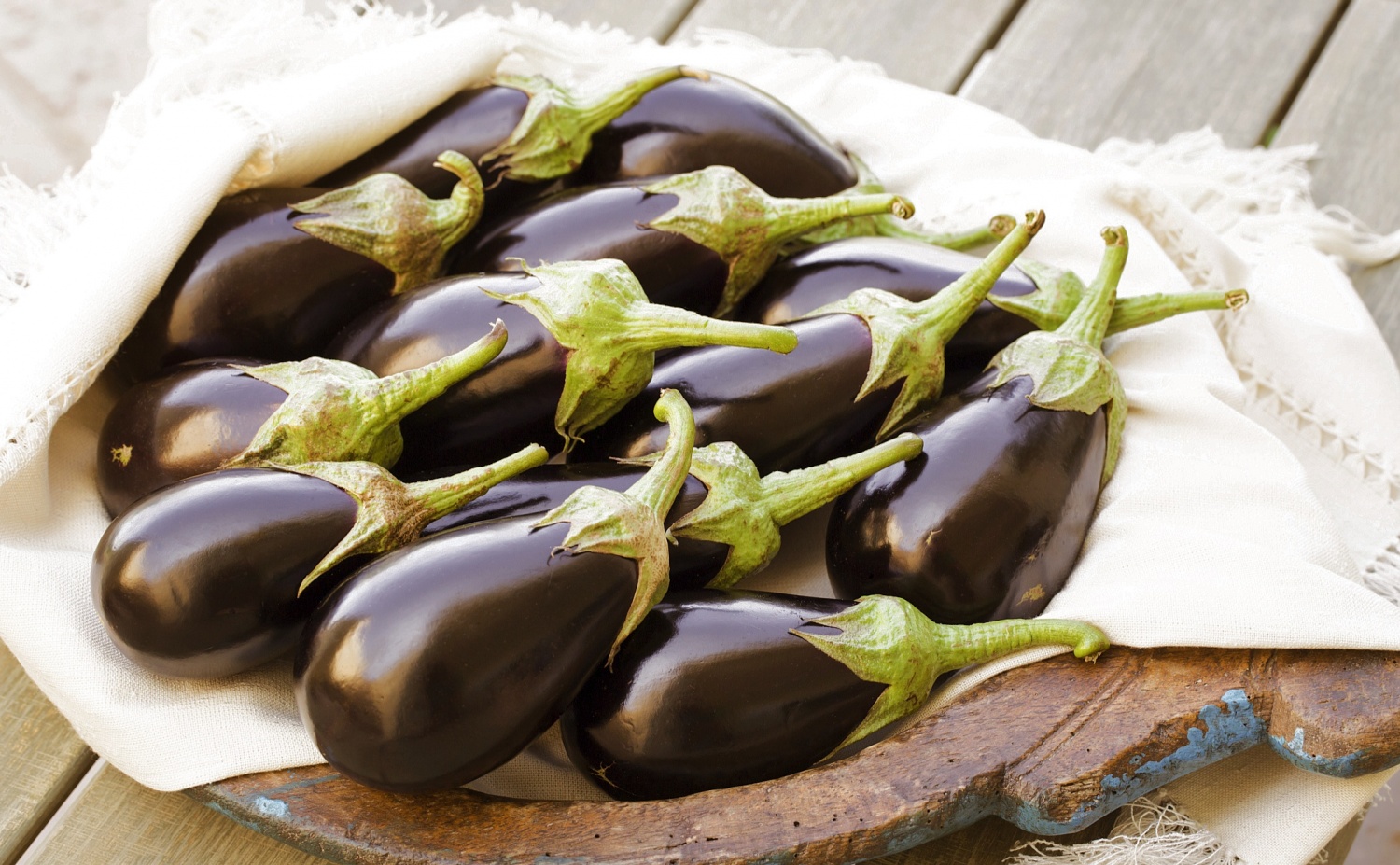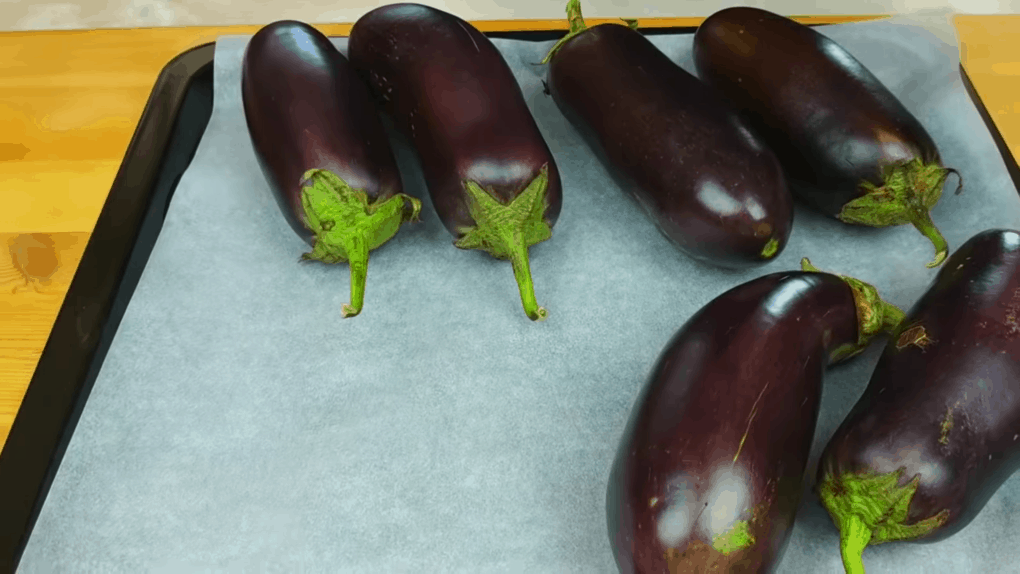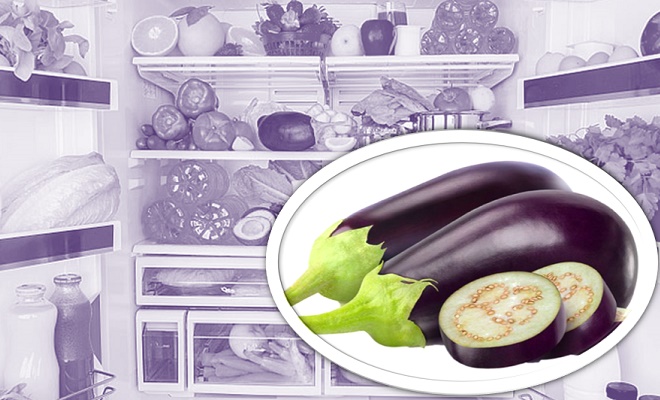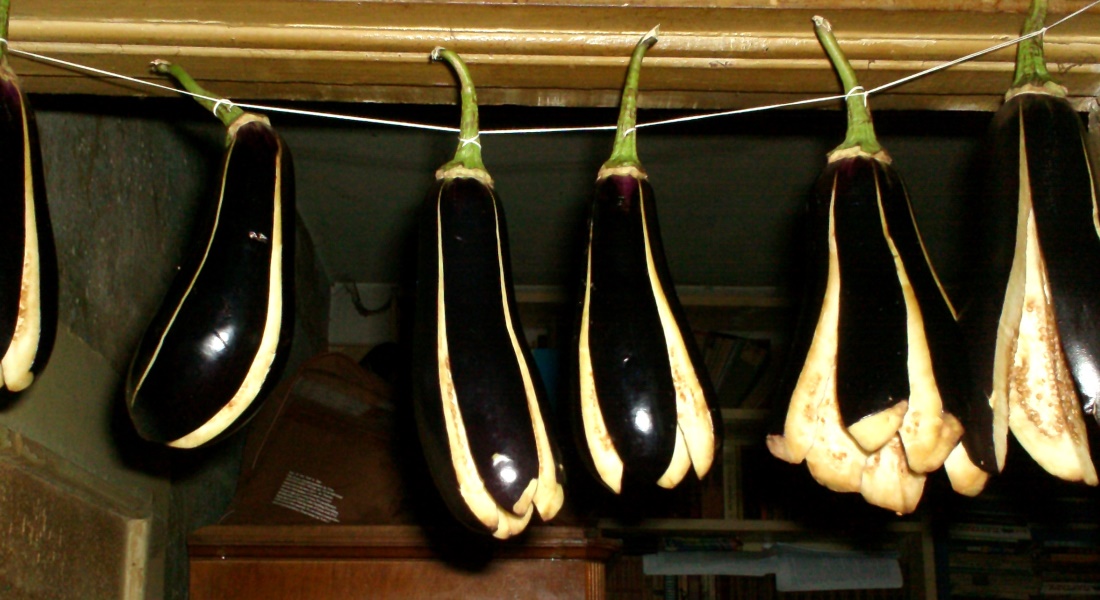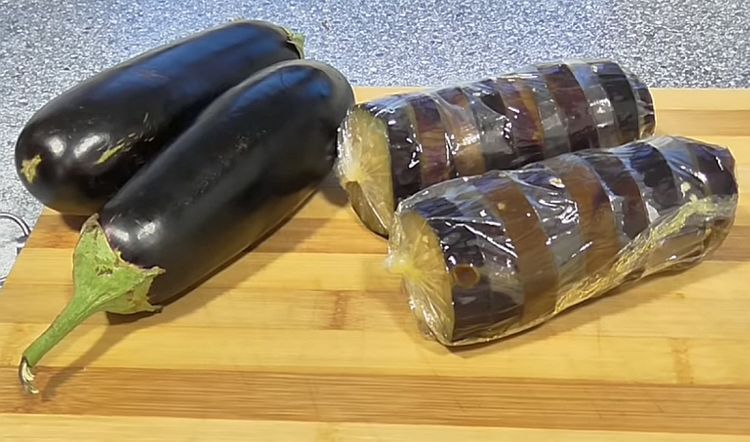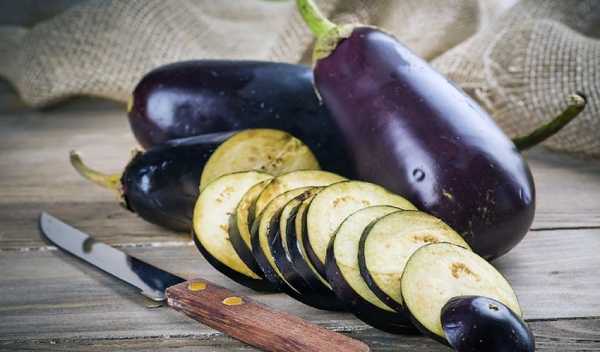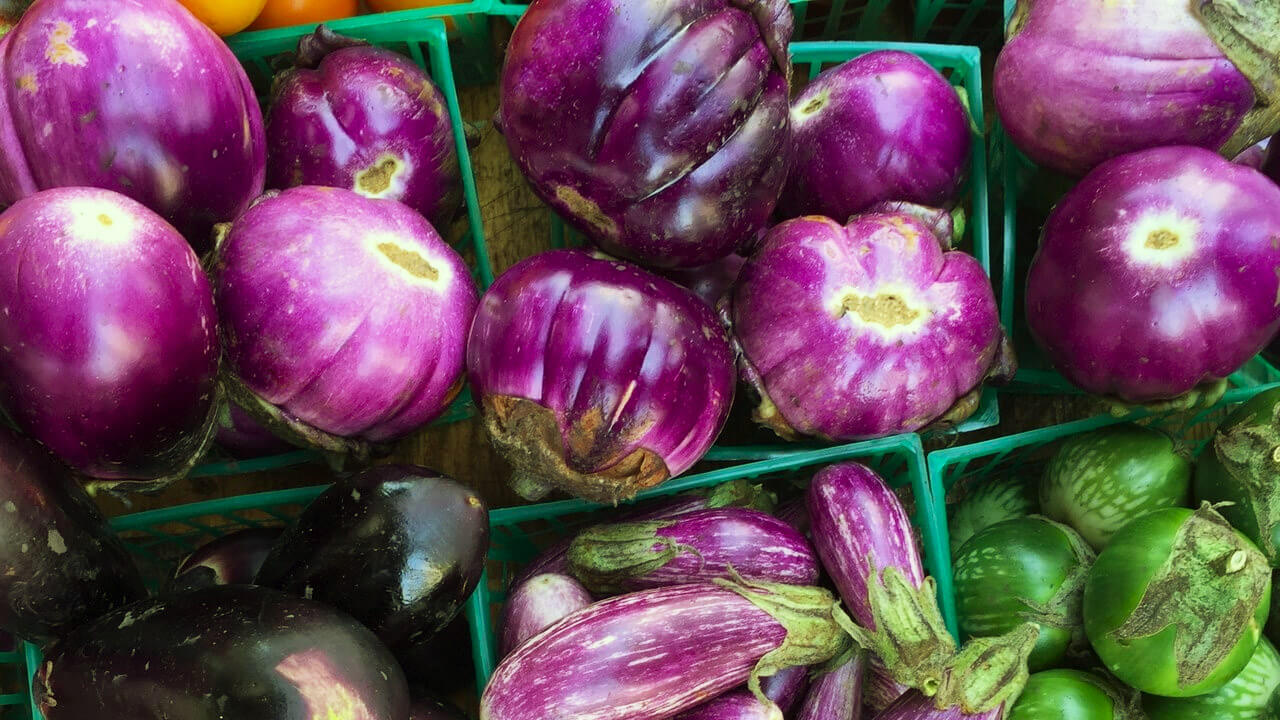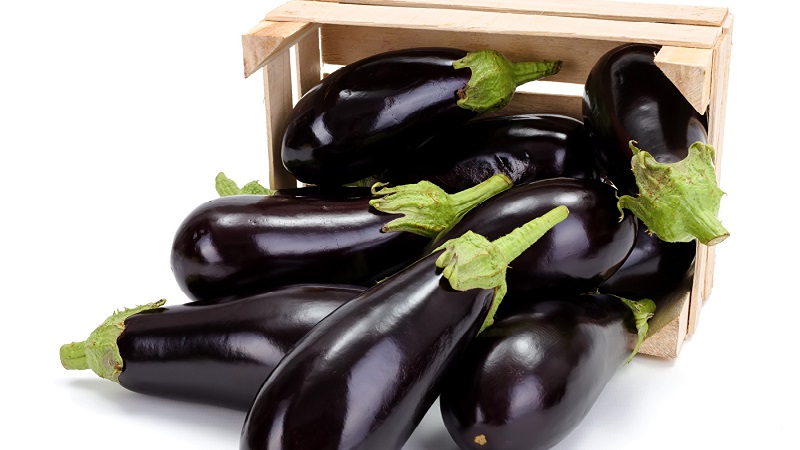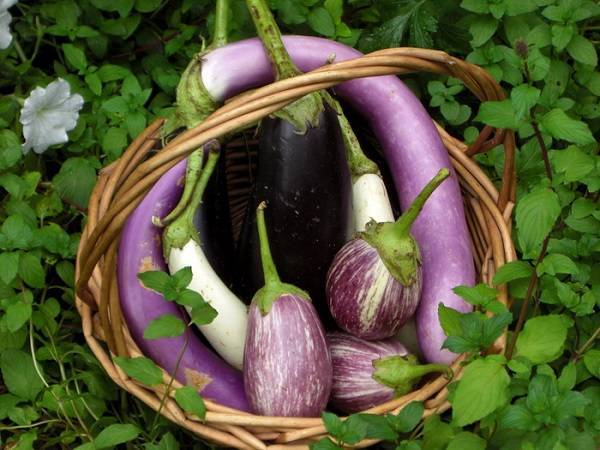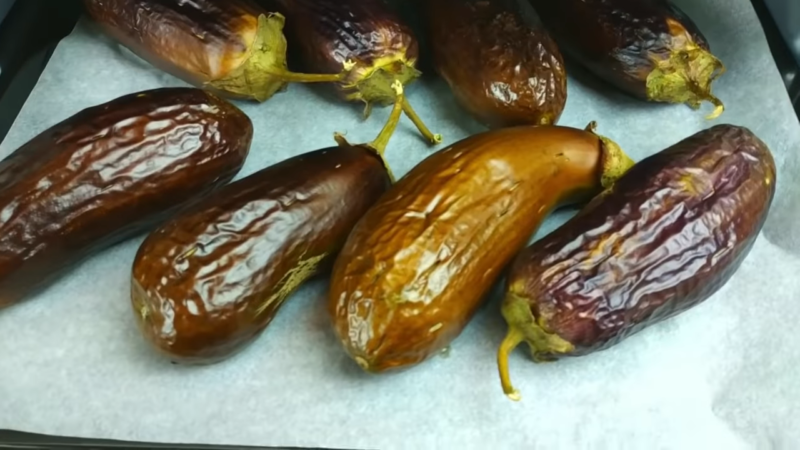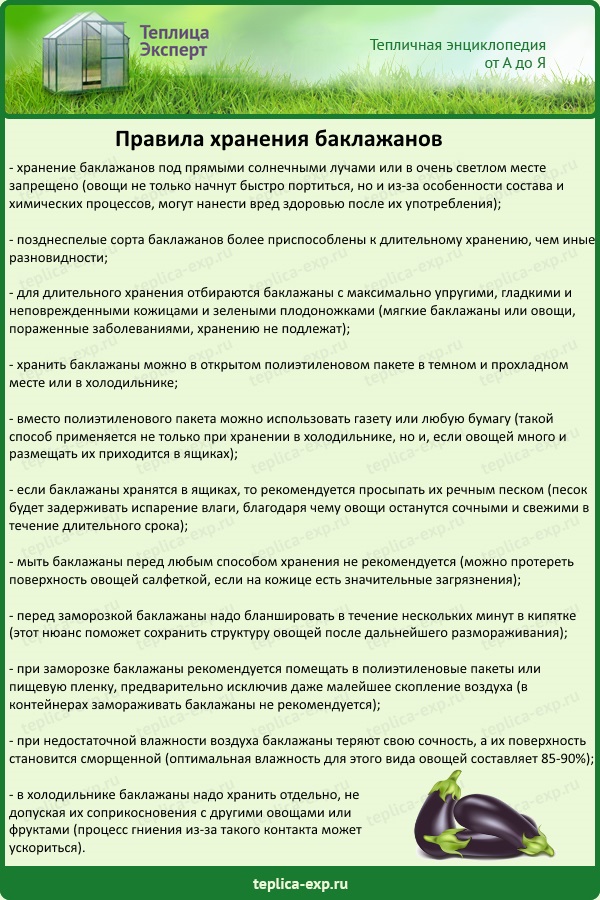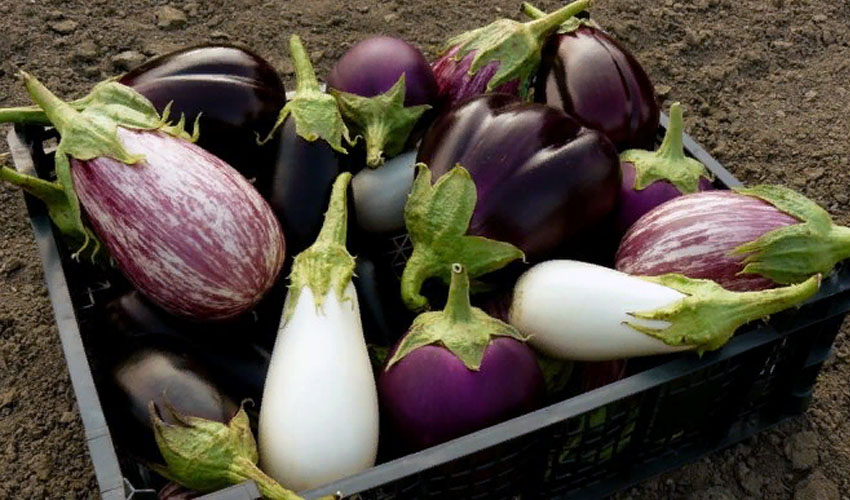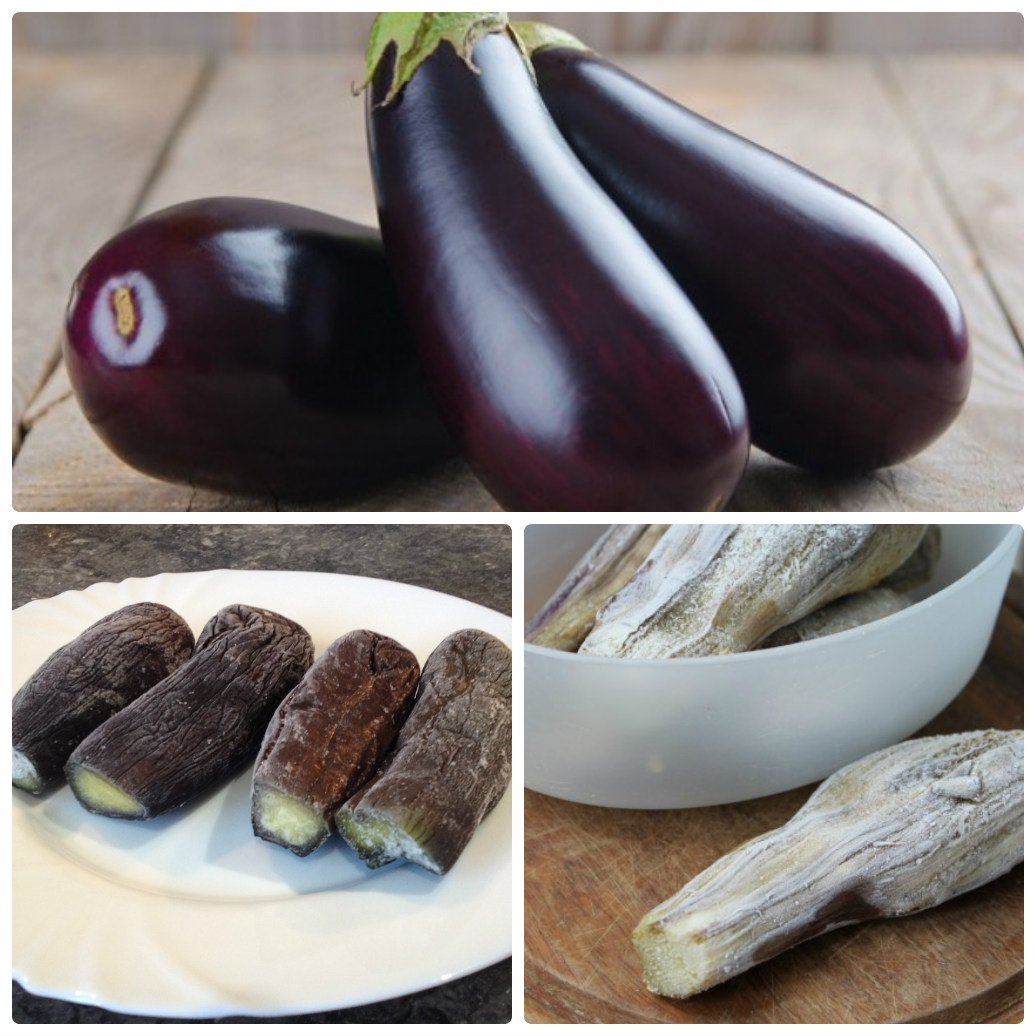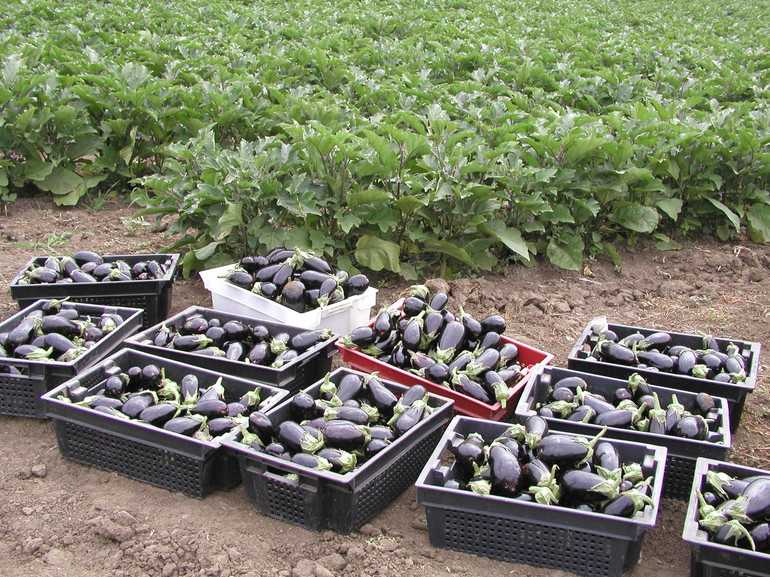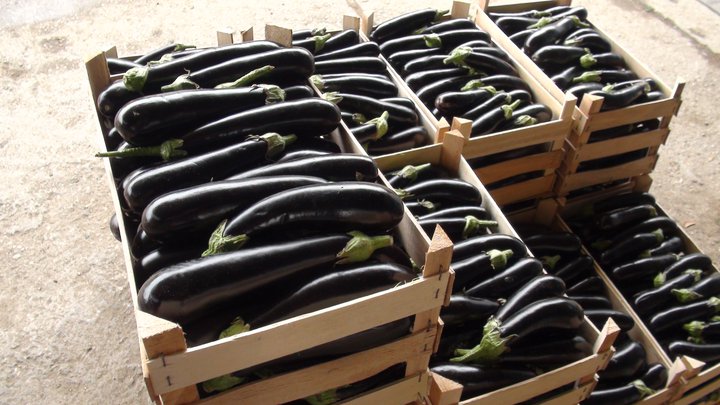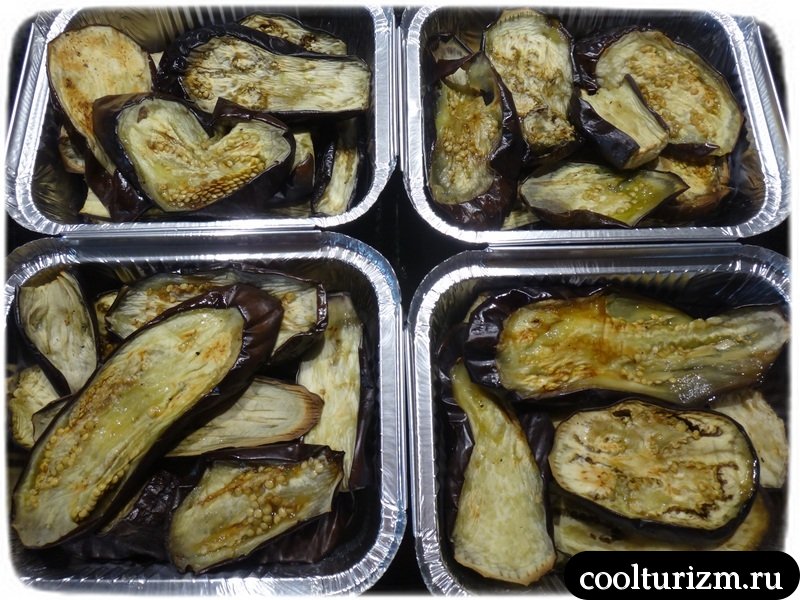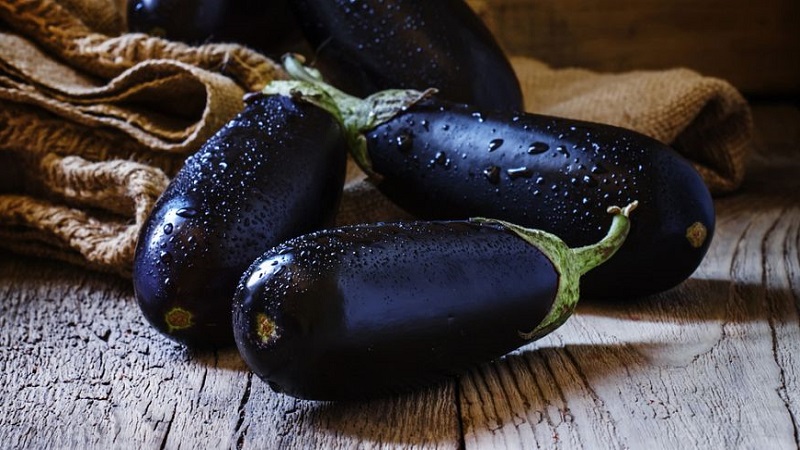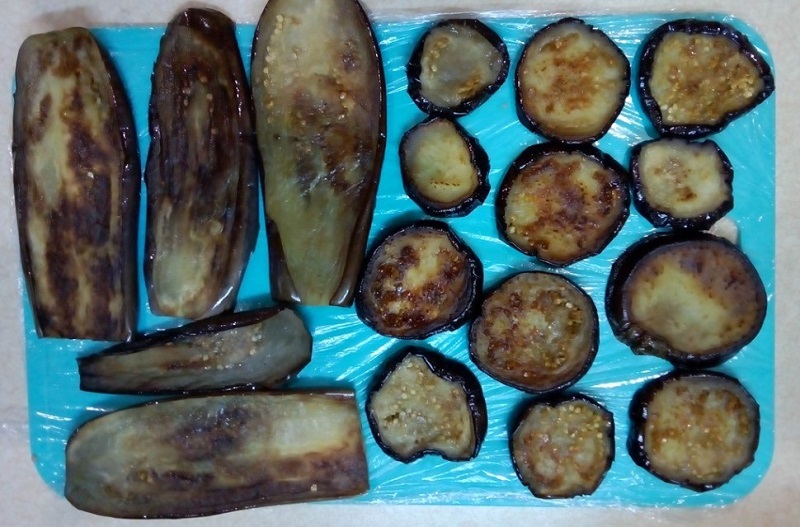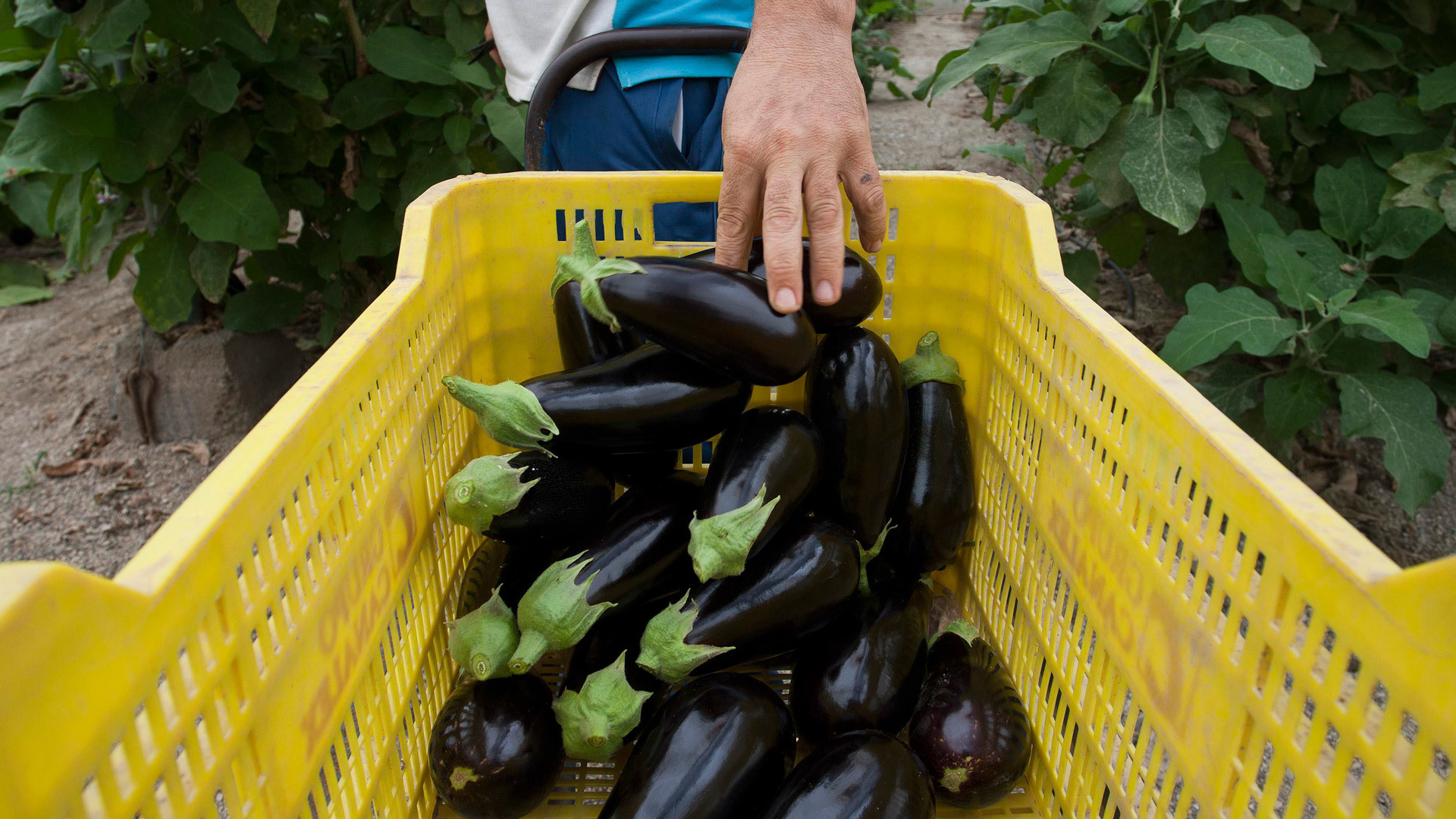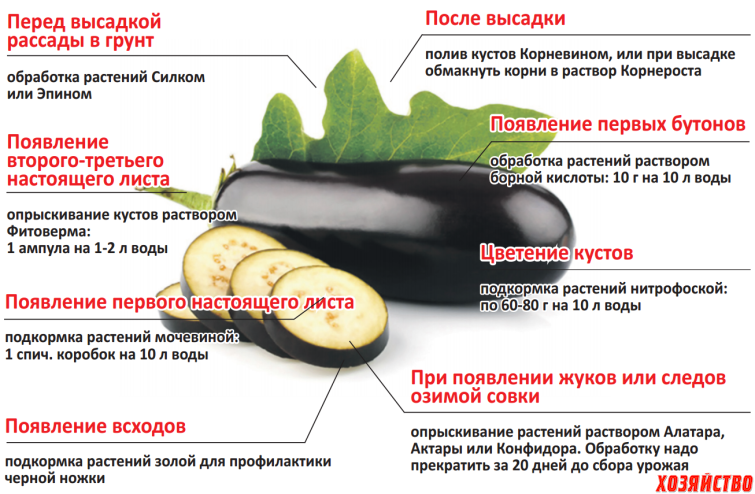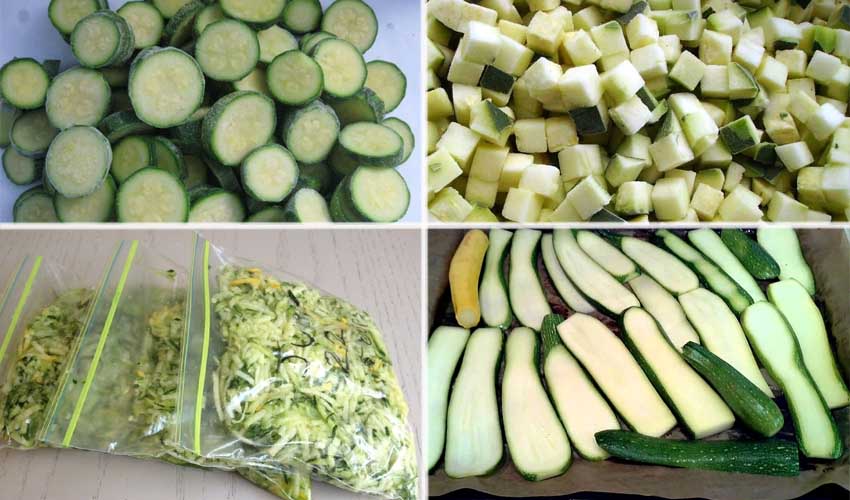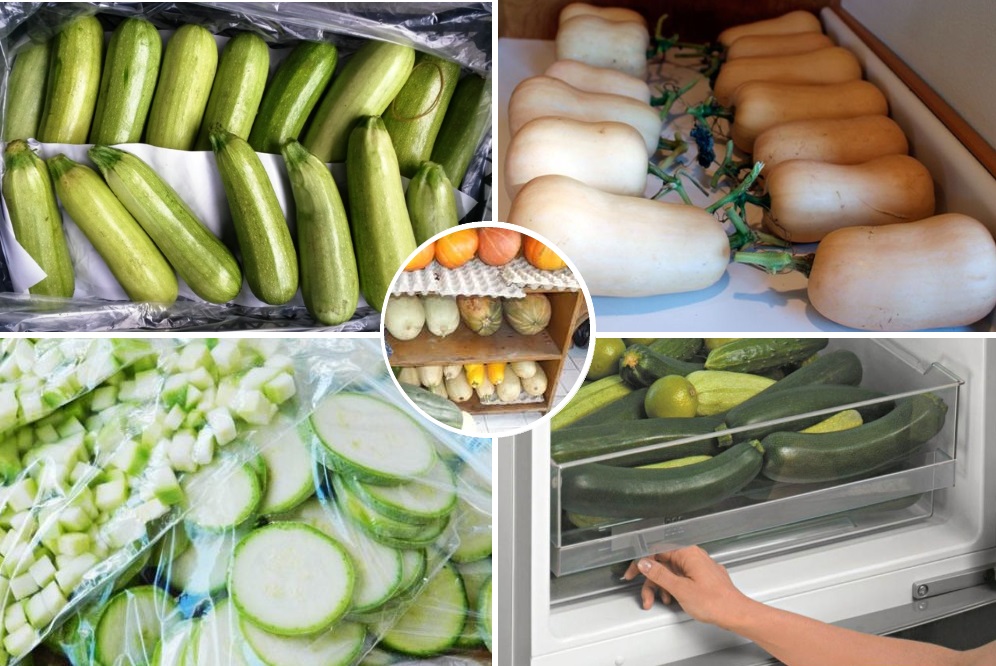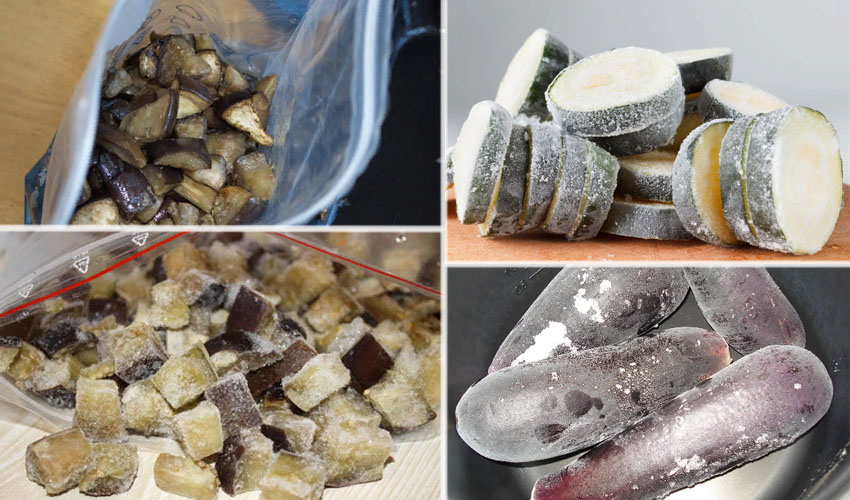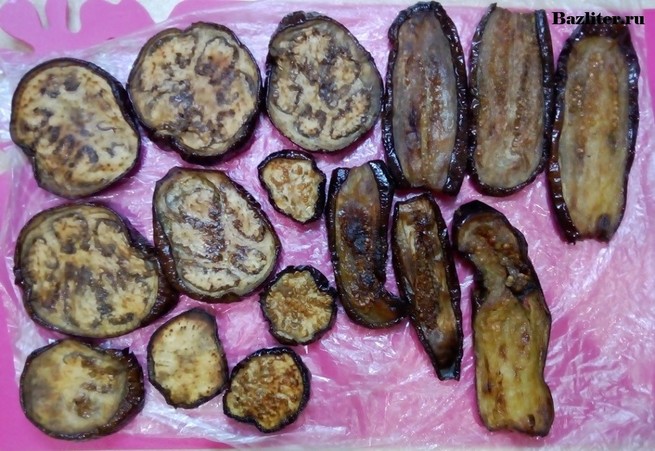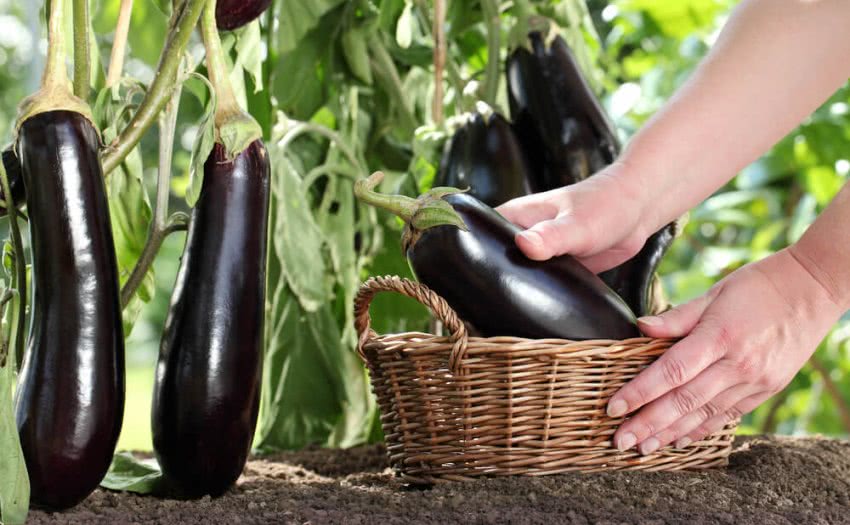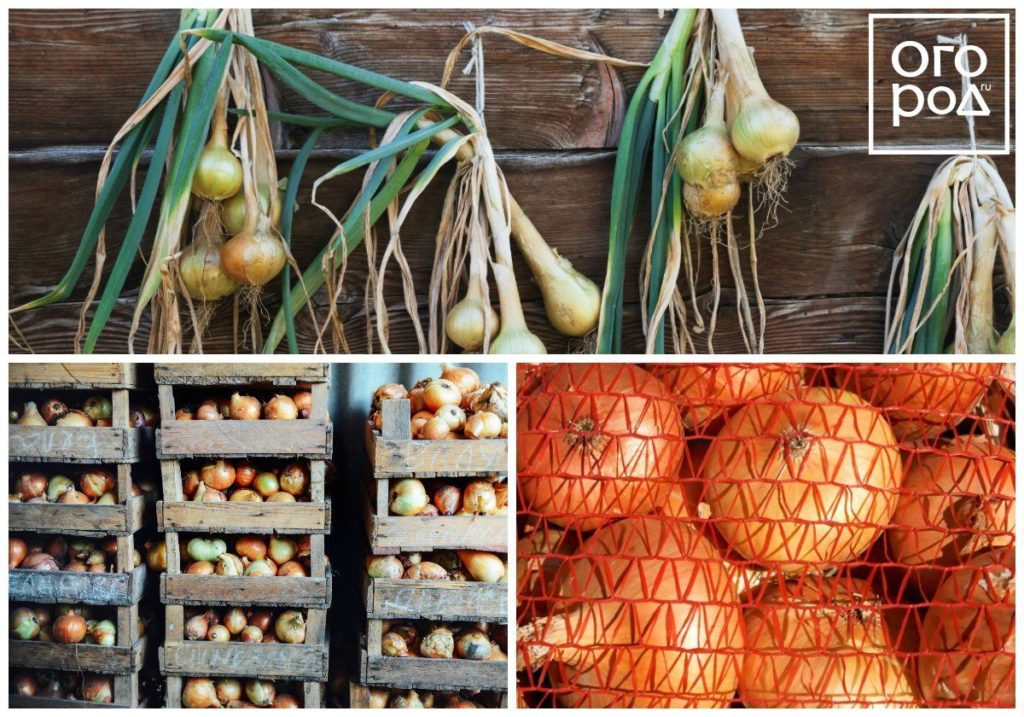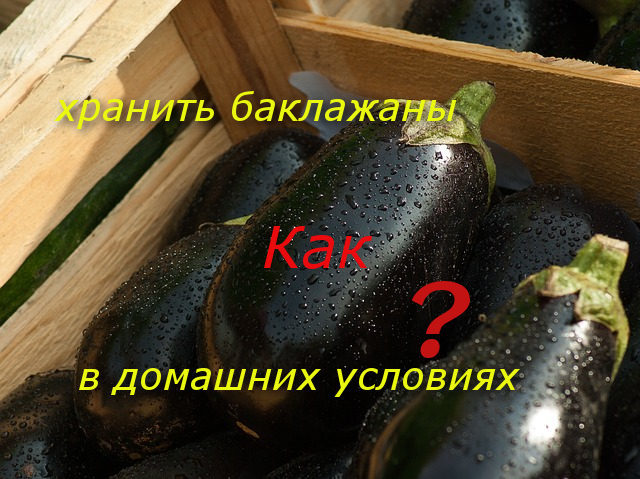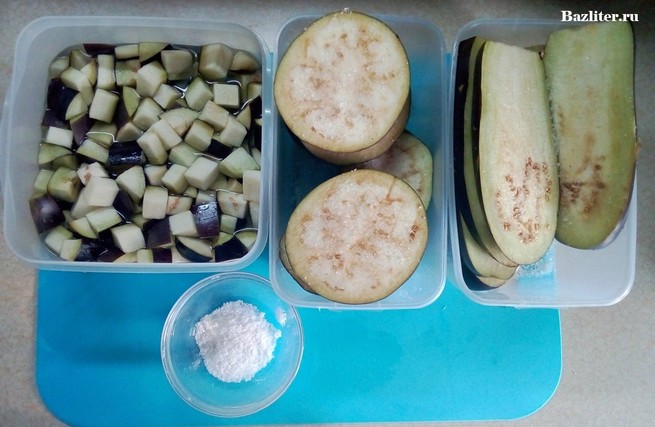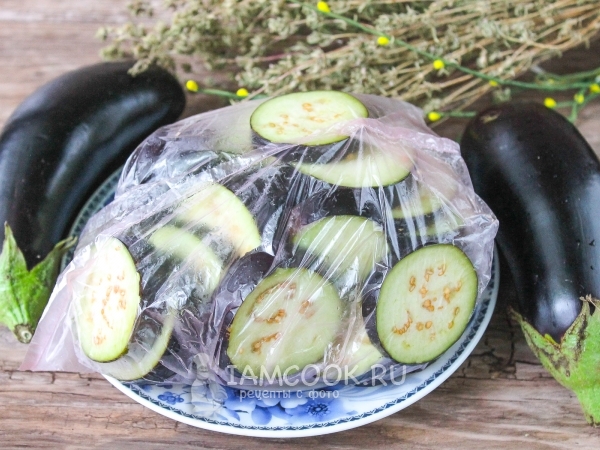When to pick eggplant: the timing of the ripening of the crop
As a rule, the technical ripeness of eggplant fruits occurs on average one month after their flowering. Of course, the earlier varieties ripen in 25 days, the later ones in 35-40 days. If you count from the moment of sowing seeds for seedlings, then this is approximately 90 to 150 days.
You can determine that the eggplants are ready for harvesting by their shape and size, which should correspond to the variety (its characteristics), as well as the color of their skin, namely the characteristic glossy color of the surface. Shades of the surface of the skin also differ depending on the variety: the color is not only blue, dark purple, lilac or lilac, but also white.
In addition, in a ripe eggplant, the seeds inside should be relatively white, and the flesh should become firm. This, of course, can only be verified experimentally, namely by cutting in half.
As for the approximate timing of the eggplant harvest, on average, this is August-September (in the south, with early planting of seedlings, from the second half of July).
If you cut off the fruits too early, they will shrink (wither) very quickly and lose their taste.
If, on the contrary, you let them overripe, the color of the fruit will become "brown" (not glossy, but dull), the flesh will not be white, but brown, tough and tasteless (with a bitter taste), and the seeds will be dark.
Video: Harvesting Eggplant
How to harvest
When harvesting, follow these guidelines and rules:
- Cut the fruits optimally in dry weather.
- Eggplant is harvested not immediately, but gradually as it ripens (every 5-7 days), choosing the most ripe fruits.
- It is most convenient to cut the fruit with a pruner, or use a sharp knife.
- When cutting, it is recommended to leave a small tail up to 4-5 cm long.
- It is impossible to wash the fruits after collection for storage, which is why it is recommended to collect them only in dry weather.
Video: when and how to cut eggplants, and then put away for storage
When is it time to remove eggplants from a bush in a greenhouse
Ripening of eggplants lasts from 80 to 150 days and depends on the variety - they are early, middle and late. Vegetables are harvested selectively, as they ripen, and not all at once.
Maturation is influenced by the following factors:
- sowing time;
- variety and quality of seeds;
- weather;
- features of care.
During the ripening period, eggplants are harvested every 5-7 days. Overripe should not be allowed - they become unfit for food.
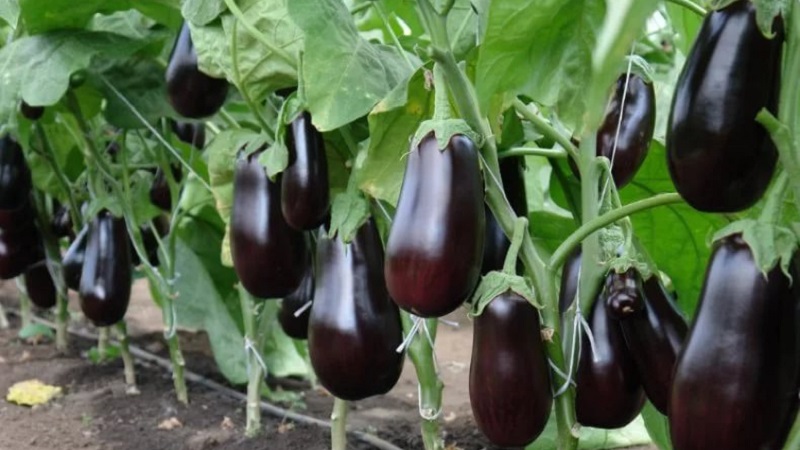
Ripening terms
Early varieties of eggplants delight with quick ripening. Their main advantage is resistance to low temperatures and poor lighting.
Within the group of early varieties and hybrids, there are subgroups and favorites.
Ripening in 60-70 days:
- Valentine F1;
- Bibo F1;
- Fabina F1.
For 70-80 days:
- Nadir;
- Black handsome;
- Diamond.
For 90-100 days:
- Robin the Hood;
- Giselle F1.
The ripening period for medium early eggplants and hybrids also varies.
Ripening in 100-115 days:
- White Night;
- Bullish heart F1;
- Alekseevsky.
For 120-140 days:
- Sancho Panza;
- Black Moon F1;
- Namesake.
Eggplants of late varieties delight gardeners in the midst of autumn.
Ripening in 120-135 days:
- City F1;
- Black handsome.
For 135-150 days:
- Sophia;
- Bullish forehead;
- Mishutka.
On average, from 1 sq. m greenhouses collect 5-7 kg of eggplants. One bush gives up to eight fruits.
Where to store vegetables and fruits at home
In the refrigerator: artichokes, Brussels sprouts, grapes, cherries, blueberries, mushrooms, blackberries, green beans, zucchini, cabbage, strawberries, leeks, vegetables with leaves, raspberries, beets, celery, plums, asparagus, herbs (except basil) , black currant, spinach.
In the refrigerator in a package: broccoli, peas, green onions, corn, carrots, radishes, lettuce, cauliflower.
In the refrigerator separately from other vegetables and fruits (they release ethylene): apricots, figs, apples (when stored for more than 7 days).
On the shelf / table: pineapple, oranges, watermelon, basil, eggplant, pomegranate, grapefruit, melon, ginger, potatoes, onions, mangoes, tangerines, limes, lemons, cucumbers, papaya, peppers, tomatoes, pumpkin, garlic, persimmon.
On the table separately from other vegetables and fruits: bananas, tomatoes, apples (if stored for less than 7 days).
Let it ripen on the shelf, and then in the refrigerator (separately from other fruits and vegetables): avocado, kiwi (does not emit ethylene, can be stored with other fruits), pears, nectarine, peaches, plums.
To keep the greens (or any grass) fresh, cut off the tips and place the plants in water (like flowers in a vase).
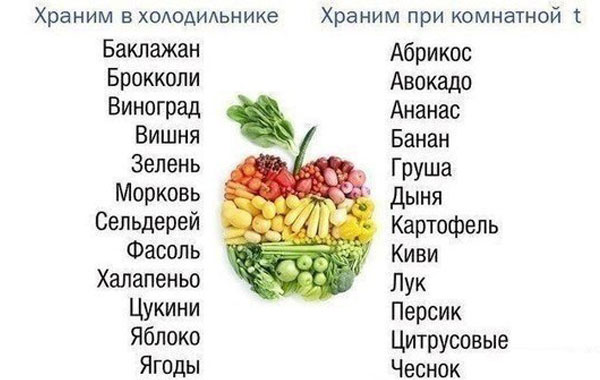
Let's clarify some points.
Why store separately
As soon as fruits and vegetables are harvested, they begin to emit an unpleasant and harmful gas - ethylene. All fruits produce it, but there are those that excrete it in large quantities.
If ethylene-producing plants are kept together with vegetables or fruits sensitive to this gas in a closed container or bag, then the process of ripening of products begins to accelerate significantly, and therefore they begin to deteriorate faster. True, this phenomenon can be used for good purposes. For example, if you put an apple with unripe bananas or avocados, they will ripen faster.
How to store fruits and vegetables without a refrigerator
To keep food fresh for as long as possible, avoid direct sunlight on the surface.
You should not leave vegetables and fruits in sealed plastic bags, this leads to a slowdown in ripening, and even to rotting due to the lack of oxygen and the accumulation of carbon dioxide inside the bag. Always give preference to environmentally friendly packaging and storage containers - wooden boxes, paper bags, etc.
If you want to speed up the ripening of any vegetable or fruit, then add an apple to it (1 fruit for every 5 - 7 pieces of the product). Due to the ethylene released by the apples, the ripening process will accelerate.
Most likely, many are surprised that, for example, watermelon or bananas cannot be stored in the refrigerator. The fact is that bananas have black skin at low temperatures. Watermelons lose their aroma and color when stored for more than 3 days in the refrigerator. Pink tomatoes ripen faster at room temperature.
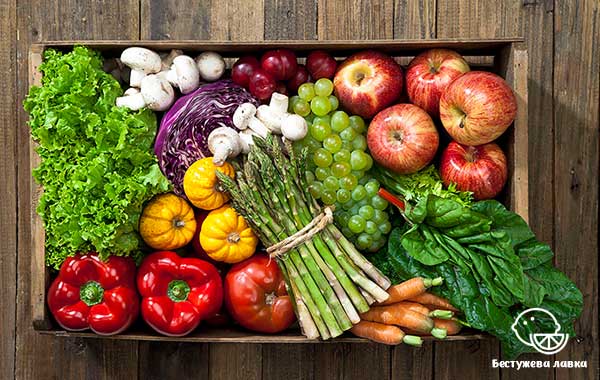
Storing vegetables and fruits in the refrigerator
Do not wash vegetable products before sending them to the refrigerator, as mold may appear on their surface. If you have already done this, then dry them thoroughly.
Other ways to store eggplant for the winter
There are several other ways to keep this vegetable fresh.
On the balcony or loggia
If your loggia or glazed balcony maintains a suitable temperature and humidity, then eggplants can be stored there, preparing them in the same way as if you stored them in a cellar or pantry.
In fridge
The shelf life of eggplants in the refrigerator is no longer than two weeks. But to do this, they need to be wrapped in paper napkins or towels and put in a ventilated bag. Without paper wrapping, the fruit will lie less. Make sure that no condensation forms on the fruit. The formation of moisture is facilitated by the constant opening and closing of the refrigerator, which leads to temperature changes in the main compartment.
Freezing
Before freezing, the fruits must be prepared: cut off the stalks and cut the eggplants into rings or cubes. In order for the fruits not to taste bitter, it is recommended to sprinkle the prepared slices with salt and leave in this position for a quarter of an hour, and then rinse. Next, the eggplants are blanched in boiling water (no more than a minute) and then dipped in cold water. After the vegetables are dry, cover them with plastic wrap and place them in the freezer to freeze. After 4 hours, remove the frozen food, transfer in portions to sealed bags and place in the chamber for further storage.
Air drying
Eggplants can be dried naturally or in special dryers and ovens. It will take several days to dry outdoors. Before drying, wash the fruit and wipe it with a clean dry cloth.Cut into lobes or rings and place on a baking sheet or a special drying net. You can also thread semi-finished products onto a rope and dry on it. Care should be taken when choosing a place for drying. The sun's rays should not fall on the fruits. The place where the eggplants will be dried should be ventilated.
 On the left are naturally dried fruits, on the right in the oven.
On the left are naturally dried fruits, on the right in the oven.
Drying in the oven
If you do not want or do not have the opportunity to dry for several days, then use the oven. It is faster and you have a guarantee that toxic solanine will not accumulate in the fruit under the influence of sunlight. Place the washed and sliced eggplants for drying on a baking sheet and put in an oven preheated to 50 degrees for 6 hours. After six hours of drying, check the result, if wet areas are visible on the workpiece, then the process must be extended until they are completely dry.
Canned preparations and eggplant caviar
This is the most common way of storing fruits among housewives in our country. Eggplants are not the most suitable vegetable for long-term storage, so they are most often frozen or canned.
 Prepare eggplant caviar for the winter.
Prepare eggplant caviar for the winter.
There are many recipes for making eggplant blanks for the winter. Moreover, eggplants can be canned either separately or mixed with other vegetables.
The most favorite and familiar option for our tables is vegetable caviar:
- For 1 kg of eggplant, take 1 kg of tomatoes, 500 g of onions, 500 g of sweet peppers, 400 g of apples, 200 g of carrots and parsley root. Salt and pepper to taste.
- All vegetables are peeled, tomatoes are blanched. The eggplants are cut into rings, sprinkled with salt and washed after 20 minutes (in order to remove the bitterness), dried and lightly fried in vegetable oil.
- All other vegetables are crushed and lightly sautéed in vegetable oil. Pass cooked sautéed vegetables and sautéed eggplant through a meat grinder.
- Put the resulting mixture in an enamel saucepan on fire, bring to a boil and then keep on low heat for about 30 minutes.
- Add peeled and minced apples 3 minutes before cooking.
- Pour into sterilized jars and roll up. From the listed number of products, you should get 2 liters of ready-made vegetable caviar.
- Store the workpiece in a cool, dark place.
Storage preparation
Preparing for storing eggplants is a painstaking and troublesome process. The most suitable for long-term storage are late-ripening eggplant varieties. They are harvested before frost in dry weather.
This will protect the fruit from fungal infection. The fruits must be cut with a sharp knife, leaving about three centimeters at the stalk.
With this cutting of the stalk, the fruit will not dry out for a long time, and will not be susceptible to infection. Eggplants are not washed before storage, but wiped with a dry cloth or paper towel. The fruits must be dried after harvesting, just not in the sun, as their action leads to the formation of solanine, which is dangerous to health.
Storage temperature should be from plus 3 to minus 5 degrees. The maximum temperature is plus 10 degrees. At the same time, it is necessary to monitor the humidity, which should not exceed 75 to 85 percent.
It is very important to adhere to these conditions to ensure longer storage.
Alternative methods of harvesting for the winter
To preserve the taste of eggplants for a longer time, it is recommended to preserve or dry these vegetables.

Drying
You can prepare dried vegetables at home using the oven, electric dryer, or outdoors. In order to dry eggplants, they need to be washed, dried and cut into slices or circles. Store this product in a container, paper bag or cloth bag.
Drying in the open air
After cutting, the vegetables can be laid out on a baking sheet or hung strung on a thread or fishing line. After that, it is recommended to leave them in a dry, ventilated place without direct sunlight. This method is weather dependent and requires the same humidity and temperature throughout the drying period.
Drying in an oven or electric dryer
If there is no favorable weather and there is an oven or electric dryer, then eggplants can be cooked in them. To do this, the cut fruits must be kept in the oven at a temperature of 45-55 ° C for 4-6 hours. After cooling, it is recommended to inspect them. If the fruits are not completely dry, then they need to be dried. When cooking in an electric dryer, you need to set the appropriate mode and dry for 6-8 hours.
Drying
Dried vegetables can be made in the oven or in an electric dryer. After cooking, they should have a hard crust and a soft middle. To do this, they need to be dried in an oven at a temperature of 60 ° C for 2-4 hours or in a dryer in the appropriate mode until tender. After that, they need to be placed in a container and filled with hot oil with spices. The cooled product should be stored in the refrigerator.
Canning
Canning is the most common way to store eggplants at home. They can be salted, fermented, pickled or made into eggplant caviar. Also, these vegetables can be preserved in tomato juice or oil.

Salty
To prepare salted eggplants, you need to put the chopped fruits in a saucepan or other container, add chopped dill and garlic to them, cover with salt (2-3% of the weight of vegetables in salt equivalent) and mix. After that, leave under oppression for 2-4 days at a temperature of 18-24 ° C until the brine becomes cloudy.
Pickled
The composition of seaming with pickled eggplants includes:
- fresh fruits - 2.5-3 kilograms;
- 3-4 cloves of garlic;
- salt - 4 tablespoons for cooking, 10-15 grams for garlic and 30-40 grams for making brine;
- 1-2 bay leaves;
- 0.5 liters of brine water.
In order to cook vegetables, you need:
- Cut off the tails of the fruit and prick them with a toothpick over the entire area.
- Boil them for 10-20 minutes in salted water (2 tablespoons per 1 liter) until wrinkles appear on the peel.
- Press vegetables at an angle for 7-12 hours.
- Rub the peeled garlic with salt.
- Cut along the fruit into 2 equal parts and brush over the entire surface with the garlic mixture.
- Fold bay leaves (peppercorns and / or cloves to taste) and eggplants on the bottom of the container.
- Prepare a brine in the ratio of 60 grams of salt to 1 liter of water. Let it cool and then pour it into a container with vegetables.
- Cover the container with the ingredients and leave to ferment for 5-7 days at a temperature of 19-24 ° C.
- At the end of fermentation, remove the container to a cool place for further storage.
Appetizer with vegetables
These vegetables can be cooked with a variety of vegetables such as carrots, tomatoes, or bell peppers. The pepper recipe includes:
- eggplant - 1.5 kilograms;
- bell pepper - 500 grams and chili - 50 grams;
- garlic - 70-80 grams;
- vegetable oil - 90-120 grams;
- vinegar - 10-12 tablespoons;
- honey - 110-120 grams (can be replaced with sugar);
- salt - 2 tablespoons.
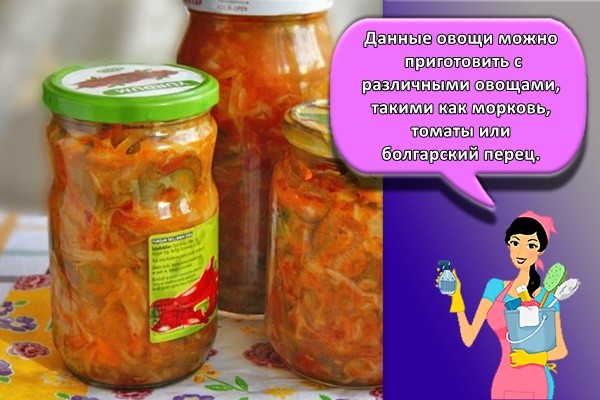
In order to cook these vegetables with hot and bell peppers, you need:
- Wash, dry and cut the fruits into slices up to 1 centimeter thick.
- Place parchment paper on a baking sheet and chopped eggplants on top. Leaves and vegetables must be thoroughly greased with vegetable oil.
- Prepare a dressing from peppers and garlic peeled from seeds and tails. To do this, they need to be cut into pieces and grind with a blender or meat grinder.
- Add vinegar, honey (or sugar), salt to the resulting mass and mix thoroughly.
- Put vegetables and dressing in jars, alternating layers (for 1 layer of eggplant, you need 2 tablespoons of the mixture on top and bottom).
- Place the jars in water and boil for 15 minutes.
- Roll up the container with lids, turn over and let cool.
Eggplant storage features
The pulp of these vegetables contains a lot of active water, so they do not keep fresh for a long time.
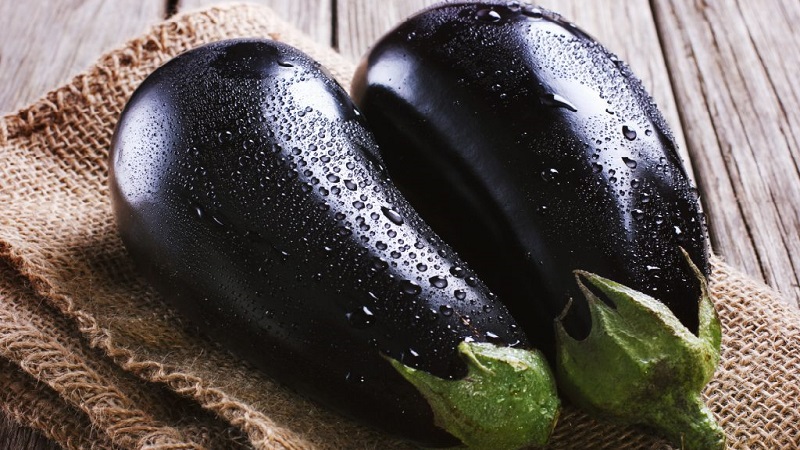
The success of keeping fresh vegetables at home depends on three parameters:
- air humidity;
- temperature;
- illumination.
Optimum temperature conditions for eggplants are + 2… + 6 ° C.
Suitable air humidity is 75–85%. Higher rates increase the risk of rot development, and at low humidity the fruits lose their juiciness and wrinkle.
Lack of light is a prerequisite for storing this member of the nightshade family. In the light, solanine, which is hazardous to health, is produced in the fruit.
How many fresh eggplants are kept
Processed, canned vegetables are stored the longest. Average shelf life of fresh eggplants depending on storage location:
- cellar (basement) - 3-4 months;
- balcony (cold storage room) - 1 month;
- refrigerator - up to 2 weeks;
- at room temperature - about a week.
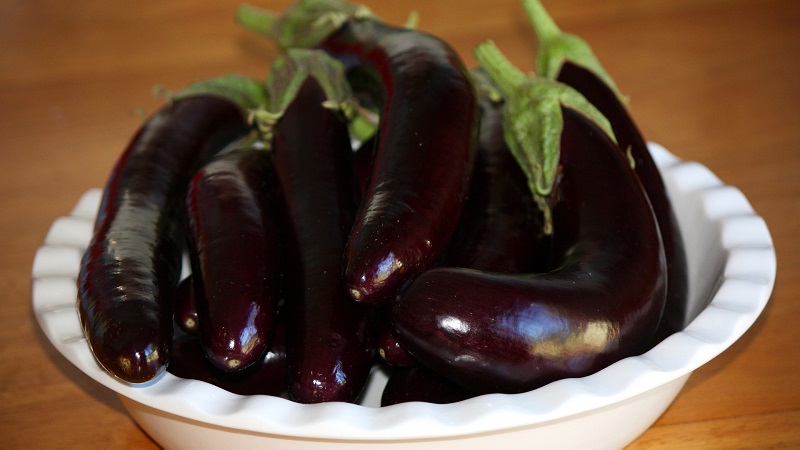
Fresh storage methods
Before deciding where and how best to store these vegetables at home, you need to consider a number of general rules:
- For long-term savings, late varieties of crops with a ripening period of 140 days or more, as well as mid-ripening ones, with a ripening period of up to 130 days, are better suited.
- It is allowed to save eggplants in an open polyethylene bag, but only in the refrigerator or in an unlit cool place.
- It is also permissible to use a newspaper or any other paper - this method is used when saving both in the refrigerator and in boxes.
- When stored in boxes, the fruits must be sprinkled with river sand - it will slow down the evaporation of moisture, which will preserve their juiciness and freshness.
- The best moisture content for storing vegetables is 85–90%. With a poor moisture content, they lose their juiciness, and the peel wrinkles.
- Sprinkling with salt is not only a good way of saving, but also a method of removing bitterness.
Important! It is categorically unacceptable to store in the light or under the influence of direct sunlight - in such conditions, an organic compound solanine is produced in eggplants, which, being a poisonous glycoalkaloid, is toxic to humans.
In a cellar or basement
In such premises, as a rule, favorable conditions for storage are - temperature + 3 ... + 5 ° С and air humidity 75–85%.

There are several ways to save blanks in the cellar (basement):
- Cover the shelves with straw. Wrap the eggplants (each fruit) in paper and arrange them on prepared shelves.
- The fruits are stacked in a box, while each layer is sprinkled with dry sand or ash. The temperature at the place of storage should not be higher than + 7 ° С.
- Two or three eggplants are wrapped in paper (plastic) bags, air is squeezed out of the bags to the maximum, then they are tightly tied. After that, they are folded into boxes on the floor with holes for ventilation. The top of the box is covered with straw, old newspapers or sawdust.
- Eggplants are folded in a net and hung. This is allowed if the room has good ventilation and the air temperature is not higher than + 3 ° C.
We recommend reading about the peculiarities of collecting eggplants in a greenhouse.
Indoor conditions
To store eggplants in an apartment or house, they will need to create a suitable environment with a temperature range of + 3 ... + 5 ° C, humidity of 75–85% and a complete absence of any light.
A loggia or an insulated balcony is suitable for this. With this method, each eggplant is wrapped in cling film and placed in a wooden box, which, in turn, is covered with dense material from light.
In fridge
To save in the refrigerator, each vegetable is also wrapped in cling film, but even so, the eggplants must be positioned so as to exclude their contact with other fruits or vegetables, otherwise there is a risk of accelerating the decay process.

They can also be saved as semi-finished products. To do this, you need to cut the fruits into circles, then fry them a little or bake them in the oven and send them to the refrigerator for storage. In winter, you can prepare a vegetable stew or pate from the workpiece.
In the freezer
The simplest and most affordable method that preserves all the valuable qualities of the product.
This requires:
- In order to preserve the structure of the fruits after defrosting, first subject them to blanching (scalding with boiling water).
- Then cut the fruit (slicing shape - arbitrary) and sprinkle the pieces with coarse salt for 15–20 minutes. Then rinse the salt. This is done to eliminate bitterness.
- For freezing, the processed pieces are placed in plastic bags or wrapped in cling film, preventing air from accumulating. But in food containers, freezing is excluded. You also need to consider: if the vegetables are cut into small cubes and put in one layer, they will freeze much faster.
How to freeze eggplants for the winter: step by step instructions with a photo
How to properly freeze eggplants for the winter can be read in the suggested recommendations. Before freezing, wash them well, dry them, cut off the stalks and, if any, spoiled areas. 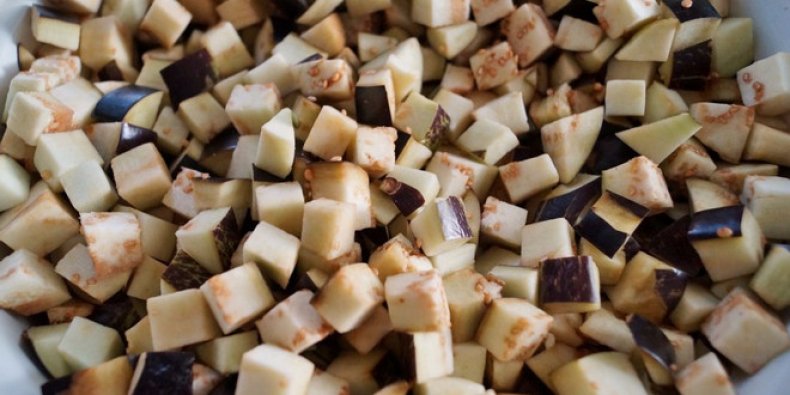 Cut them into cubes or rings as you need, put in a deep bowl, cover with cold water and salt.
Cut them into cubes or rings as you need, put in a deep bowl, cover with cold water and salt.
Leave them in this state for a couple of hours in order for the bitterness to go away, then drain the water and squeeze the cut pieces a little to get rid of excess moisture. So the eggplants are ready for freezing.
Blanched
One of the most convenient and quickest methods of freezing eggplants is blanching.
Already prepared (washed and chopped) vegetables soaked in salted water must be dipped in boiling water for 2 minutes and immediately dipped in ice, a colander will help you with this, then put the eggplant pieces on a dry towel to dry.  Ideally, put the chopped vegetable in one layer, this way moisture is better removed. Only after this procedure can everything be put into a container or bag, sealed, signed and sent to the freezer.
Ideally, put the chopped vegetable in one layer, this way moisture is better removed. Only after this procedure can everything be put into a container or bag, sealed, signed and sent to the freezer.
Oven-dry
There are housewives who do not like to blanch vegetables, so they use the drying method. To do this, you can use both a conventional oven and a vegetable dryer or airfryer.
The preparation of the blues remains the same as described above. Ideal for this method is to peel the eggplant. If you are using an oven, then put the sliced pieces on a baking sheet and cover them with foil, if you are using a dryer or airfryer, then just put everything in one layer. 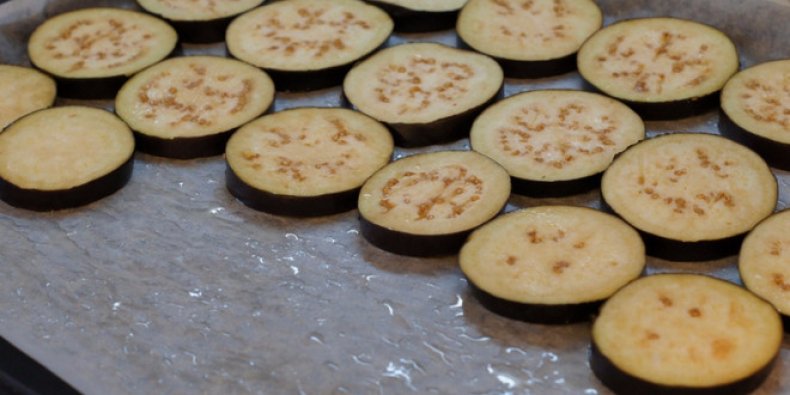 We send the contents to the oven, heated to 55-60 degrees Celsius, and leave it ajar, if there is a fan, then we also turn it on and leave it for an hour. Freezing the resulting semi-finished product is the same as described above in the article.
We send the contents to the oven, heated to 55-60 degrees Celsius, and leave it ajar, if there is a fan, then we also turn it on and leave it for an hour. Freezing the resulting semi-finished product is the same as described above in the article.
Fried eggplant for freezing
Blue's preparation does not change. After you soak them, drain and dry, heat the vegetable oil in a pan and fry the slices on all sides.
To prevent excess fat from absorbing, place the fried vegetables on dry paper towels.  Wait until they cool down, take a cutting board that fits in the freezer, wrap it with cling film and put the cooled eggplants in one layer, wrap the blanks again with cling film, put the eggplants in the second layer, and so on.
Wait until they cool down, take a cutting board that fits in the freezer, wrap it with cling film and put the cooled eggplants in one layer, wrap the blanks again with cling film, put the eggplants in the second layer, and so on.
Errors
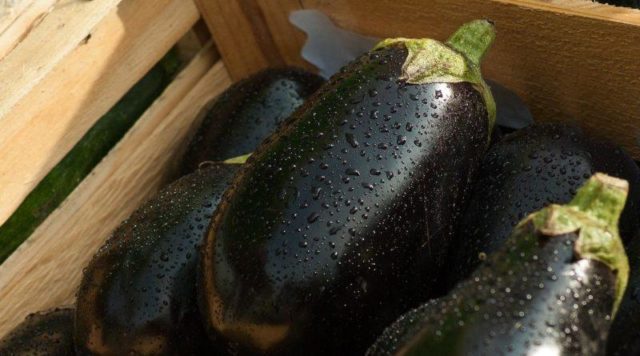
When collecting and storing crops, a large number of mistakes are made, which can lead to rapid spoilage of vegetables.
- Store fruits in the refrigerator - if you do not want the fruits to deteriorate after a couple of days, then you should not store them in this place. This is due to the high percentage of moisture that can harm them.
- Freeze Unprocessed - If you haven't cooked the eggplant and frozen it fresh, be prepared for it to be tasteless, watery, and rubbery.
- Lack of moisture during growing - when the moisture is not enough in full, when ripe, the blue ones will be unpleasantly bitter.
- Collecting in cold weather - if you harvest after the onset of a cold temperature, then there is a high probability that the eggplants will become unusable.
- Unripe and overripe - if the fruits are harvested earlier than necessary, then in a day they will wither, and with late harvest the flesh will turn brown and tasteless, the seeds are dark in color, and the color is brown.
- If you decide to grow the fruits yourself, then water them with exceptionally warm water and in no case pour them on the leaves.
- When cutting the crop, special scissors should be used, otherwise the plant can be injured and infected.
How to store a harvested eggplant crop
With a good harvest, different storage methods are used.
The storage period depends on the conditions:
- at room temperature - up to 5 days;
- in the refrigerator - no more than 2 weeks;
- on the balcony or in the pantry - about a month;
- in a basement or cellar - up to 4 months;
- in dried form - up to six months;
- in the freezer - about a year;
- in dried form - about a year;
- canned - up to 2 years.
Eggplants are stored in a basement or cellar in several ways:
- Vegetables are wrapped in paper and laid out on shelves, which are pre-covered with straw. They are covered with burlap on top (if subzero temperatures are possible, better with a blanket).
- Vegetables are stacked in a box in rows, each sprinkled with dry sand or ash.
- Vegetables are wrapped in polyethylene in several pieces so that there is no air left, sealed, put in boxes and left on the floor.
If it is not possible to store the crop in the basement or cellar, they find a place for it at home. The main thing is not to exceed the temperature above + 6 ° C, otherwise the vegetables will start to rot.
For storage in the refrigerator, each fruit is wrapped in paper or cling film. Avoid contact with fruits or other vegetables.
Eggplants are also stored on the balcony (if it is insulated), wrapped in cling film or paper. When exposed to direct sunlight, eggplant will lose not only its beautiful appearance, but also all its taste, it will become bitter. Better to put the fruits in a box and cover.
Another option is freezing. Only raw vegetables are not frozen, otherwise they will lose their taste and useful qualities. It is better to pre-fry or bake them. And then cooking will only be a pleasure, without preliminary preparation.
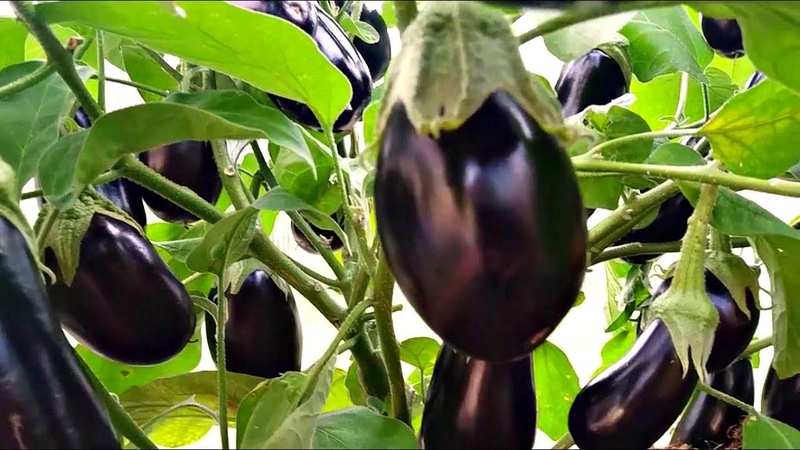
The easiest way to freeze:
- Wash thoroughly.
- Cut in a way convenient for you (slices, cubes, etc.).
- Place the eggplants in a deep bowl and sprinkle with salt. After 30-40 minutes, drain the resulting juice. Bitterness will go away with it.
- Blanch the fruits for about 5 minutes, put in a colander in order to get rid of unnecessary liquid.
- Arrange the finished eggplants on a plate and place in the freezer. It is good if there is a separate box for this so that the fruits do not absorb foreign aromas.
- After 1-2 hours, take out the eggplants and pack them in bags. So they will not stick together.
The baked vegetables are frozen like this. Wash, cut into slices and bake. Salt and add your favorite spices. Finished vegetables are cooled, wrapped in cling film and placed in the freezer. This way they retain their beneficial properties as much as possible.
Loosening and hilling
After watering, a crust forms on the surface of the soil, which prevents air from penetrating to the roots.Lack of oxygen leads to a delay in the growth of roots and, as a result, of the entire plant. For this reason, one of the mandatory procedures for growing eggplants is regular (ideally, after each watering) loosening.
It is necessary to loosen the ground to a depth of no more than 4-5 cm so as not to hurt the roots
This is important because the root system of eggplants is not restored and additional roots, as, for example, on tomato stems, do not appear
Simultaneously with loosening, hilling should also be carried out - pouring earth to the trunk of the plant.
Fundamental rules
There are different ways to preserve this perishable product in order to enjoy its taste for a long time.
How to store eggplants: they are stored raw, frozen, dried and canned.
When stored raw, there are strict rules to follow:
- take unripe fruits of the latest variety;
- eggplants that are not damaged are subject to storage;
- storage takes place with complete isolation from ultraviolet rays;
- do not wash the eggplants before storage, do not cut the stalk;
- it is necessary to conduct a constant revision of vegetables, once every 10–12 days, remove spoiled eggplant immediately.
The aging time of the vegetable in proper condition also depends on the temperature regime.
Eggplant can be stored in the refrigerator, basement, or cellar.
The cellar, or basement, is the ideal place to keep fresh vegetables. It should be ventilated, humidity 70–80%, temperature range +3 to + 6 ° С. Wipe the vegetables with a cloth towel. It is best to place them in boxes of straw or dry sawdust, cuttings down. If there are none, each eggplant is wrapped in newspaper or paper and placed in ventilated boxes, burlap is covered on top.
The refrigerator is not as effective in keeping this product safe, but it will be a good alternative in the absence of a cellar. Ideal if the refrigerator is equipped with a circulating cold air system. The temperature should not exceed + 8 ° С. Each fruit is wrapped in a paper towel and placed individually in a plastic bag.
The best option is the presence of a glazed balcony, where the air temperature does not drop below + 3 ° C. Laying method: in breathable boxes, stalks down, covered with straw or burlap on top.
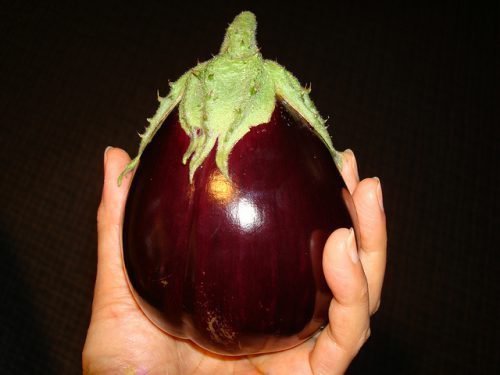
Eggplant should be stored unwashed and stalked
Different ways to store eggplants at home
How to store eggplants at home, there are some storage methods for this.
Dark place
A dark place for storing fruit is the cellar, basement and pantry.
Place the eggplants in a cardboard box. At the same time, when laying, you need to separate them from each other with paper partitions, you can also use hay or straw, if you have one. It is advisable to lay out from one to three layers, since insufficient air circulation can lead to the fact that the fruits begin to deteriorate, or mold will appear on them. After two weeks, the eggplants need to be sorted and litter changed. To do this, you need to remove spoiled fruits, if any. Then re-shift, also separating them with partitions, and leave for long storage.
There is another unique storage method - it is to cover the fruits with wood ash. Before falling asleep, you need to put the eggplants in a deep box, preferably wooden, and store at a temperature of plus 7 degrees.
The method of hanging eggplant is the most original storage option. To do this, use a regular mesh, in which the fruits are laid, then the mesh is stretched and fixed. After that, the eggplants must be arranged in one layer. The temperature with this option should be maintained up to plus 3 degrees. It is also necessary that the room has access to air.
Drying eggplants
There are two ways to dry eggplants: artificial and natural.In order to dry the fruits in a natural way, you must wash them in advance. You can then either whole or cut into pieces and air dry. You can spread the eggplants at a distance from each other, on an oilcloth or baking sheet. The main thing is to ensure that the sun's rays do not fall. Also another option is to string pieces of fruit on a fishing line or thread, and hang in a well-ventilated place, you can even leave it outside.
Artificial storage is the fastest way. It consists in drying the eggplants in the oven. The fruits, crushed into medium pieces, are laid out on a baking sheet, and dried at a temperature of plus 50 degrees for 6 hours. Then, the eggplants are taken out of the oven and allowed to cool for about one hour. It is necessary to check the state of dryness. if you still need to dry it, the fruits are sent back to the oven, but the cooking time is reduced to two hours. Dried fruits can be stored in a container or dry bag.
Freeze in the refrigerator
Freezing eggplants is the quickest and easiest way to store them. When frozen, the fruits do not lose their qualities, both useful and taste. At the same time, you can cut eggplants in any size. In the refrigerator, eggplants are in plastic bags.
A few tips before freezing:
• So that the eggplant does not taste bitter, you need to sprinkle it with salt for 20 minutes, and then rinse with water;
• To preserve a rich taste, it is necessary to pour over the sliced fruits one by one, first with boiling water and then with cold water.
When stored properly, you will get the tastiest and most completely fresh eggplants.
Useful links:
Which eggplants are suitable for freezing?
The summer period is exactly the time when people are involved in the process of creating various blanks for the coming winter. Previously, housewives preferred canning, trying to pack the entire harvested crop in three-liter jars. It is no secret that preservation at home is a rather lengthy process. First you need to boil the vegetable, then sterilize the containers for future canned food, and finally, you need to roll up the vegetables.
The advent of refrigerators with large freezers in wide access gave housewives a new opportunity. Now you can freeze tasty preparations, while saving time and preserving more useful vitamins and minerals contained in vegetable crops.


If you are not into gardening, but prefer to get all the food you need from the market stalls or from the supermarket, you are strongly encouraged to read the tips on how to choose quality eggplants, as well as to understand if they are suitable for freezing.
Fortunately, eggplant is one of those vegetables whose appearance makes it easy to deduce whether a product is of good quality. Start by visually assessing the eggplant. A large fruit, as a rule, contains a huge amount of seeds inside, which in this case is not very good. Therefore, go for medium sized eggplants. They have a more delicate and juicy taste. The surface of such a fruit should be clean, even and smooth. Dark spots on the peel of the eggplant indicate that this is a vegetable grown in not the most favorable conditions.
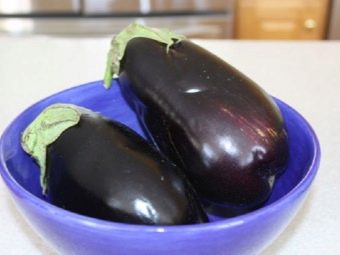
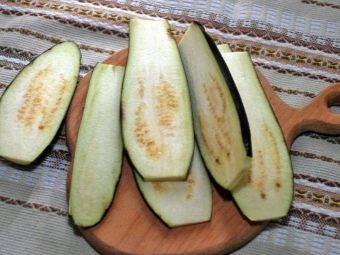
The appearance of the stalk plays a huge role in determining the quality of the product. First of all, it must be present. Its absence may be a signal that you have met a dishonest seller who wants to hide the signs of an overripe vegetable. Fresh eggplant has a bright green stalk. A mature and spoiled vegetable is characterized by a dry and wrinkled stalk.
As a rule, overripe eggplant has a bitter taste. While fresh and young vegetables do not have bitterness, but, on the contrary, are famous for their pleasant delicate taste.The purchase of fresh eggplants will greatly simplify the freezing process, since you will not have to make any manipulations to remove the bitterness from the vegetable.
So, in order for the freezing of the vegetable to be successful, it is important to choose the appropriate specimen. Selection recommendations are similar to the rules for the selection of eggplant for canning or cooking a regular dish.
It needs to be a clean, smooth, dent-free, glossy and firm-skinned vegetable. The wide variety of varieties on offer may confuse you, but that doesn't matter. For freezing, eggplants of a dark purple hue, pink, beige colors, as well as striped vegetables are suitable.

